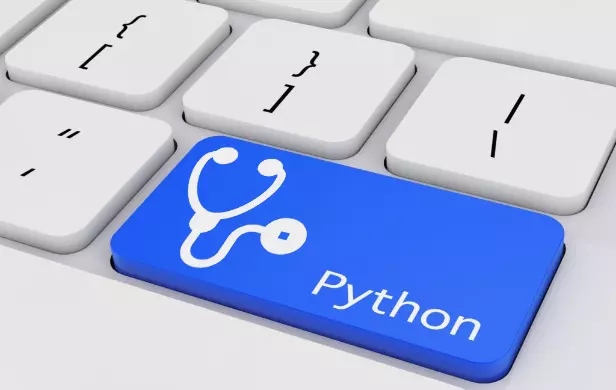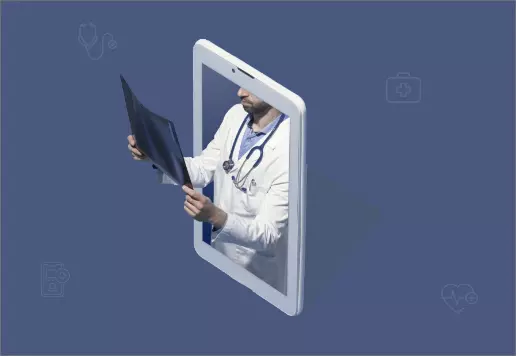Python for the better future of Healthcare
In a regular scenario, the tech industry will announce a blockbuster technology and what follows after that is a race from all the IT companies & businesses to adopt the same.
There is a belief that robust and resilient products cannot be created using old technologies. But Python defied the stereotypes and aged gracefully by staying popular all these years. With over 30 years of history, Python had a powerful influence on the evolution of software development and the lives of programming experts.
Many industries, especially healthcare confide in Python. We can explain to you why?
Before that, Let's see a little introduction to Python.
What is Python?
Python is an object-oriented high-level programming language used to build secure applications quickly. It is a popular language created by Guido van Rossum, released in 1991.
Why use Python?
Widespread popularity
With its popularity around the programming community, one can easily find a solution to any issues and quick bug fixing is possible as there is probably a solution available already for all the common issues.
Fast deployment
Python is easily accessible due to its design thus known to be one of the fastest languages for its development speed. They have a smooth environment, so the developers can spend more time on building rather than meddling with the tools.
Intuitive Code
Python's syntax is crisp and clear, as it requires only fewer lines of code that boosts the code review process and the code maintenance will be handy.
Scalability
Scalability is always a priority for a business, picking a programming language that scales significantly is vital. Python does not delay or crack up when dealing with a large amount of data. That's why it is the best choice as it can better serve its users uprightly.
Python in Healthcare: The future of good health relies on code too.
As the healthcare industry works through confidential data, adopting technologies that provide high security is of vital importance. Apart from the popularity, Python is found to be the safest programming language. This is what makes Python at the forefront in healthcare.
Let's explore how Python benefits the most for healthcare applications.
 1. Predictive Analytics
1. Predictive Analytics
The healthcare experts deploy all efforts to predict the outcome of a disease outbreak. There is a lot of trials, model development and deployment that happens while finding a treatment for a new illness. The current technology does provide solutions that can help to improve patient care by prognostically predicting the course of a disease. But they are just too expensive, difficult to scale and time-consuming to adopt in real life. So the healthcare professionals have zeroed in on Python-based ML models which can give better predictions, cost-effective and quick to implement solutions.
With the help of this solution, it is now possible to predict the mortality of patients within 12 months timeframe based on their EHR data. Utilizing PyTorch and Scikit-learn, the healthcare technology experts created a deep neural network (DNN) to predict the death dates of patients having a fatal disease. The patient's EHR can be linked to DNN which includes diagnosis, treatments and prescriptions. These DNN results will help doctors to decide when to bring in palliative care teams for their patients.
 2. Diagnosis
2. Diagnosis
Diagnostic error is one of the most daunting mistakes in healthcare and can bring down more harm. These errors happen when the diagnosis for a patient goes wrong, is delayed or missed. However, Python-based healthcare applications using data science helps to do accurate image diagnosis. Also, the Python machine learning model will be a viable solution to diagnostic conflicts. Image diagnosis such as cancer tests in oncology and bodily fluid tests in pathology are some of the diagnostic areas where ML can be applied.
The ML model will also examine EHRs to bring out diagnostic insights. It also can analyze MRIs, ECGs, DTIS and more images to identify patient disease patterns. Python code helps to build algorithms that generate a single image of a diagnosis that is easy to illuminate irrespective of the old diagnostic procedures that yield multiple images. The healthcare solutions providers have Python as a priority for their development due to its above advantages.
 3. Patient Care and Hospital Management
3. Patient Care and Hospital Management
Hospitals and clinics are completely resource-dependent. So the clinical facilities with limited staff will rely on healthcare applications to do tasks like managing patient's data, appointments and consultations. Healthcare application with Python is more secure, user-friendly, and scalable. This helps the hospital staff to concentrate on critical tasks.
Ensuring clinical staff, diagnostic and treatment facilities are available at the right time is a key challenge. Physicians need to identify the patients that miss their treatment protocols. Critical patients need experienced staff to take care of them. These processes are securely backed by the Python-based ML model.
For healthcare providers who wish to establish their remote care capabilities, ClinaNG™ is the best telehealth solution suitable for them, enabling them to meet patients virtually from anywhere, prescribe medicines and treatments as well as increase practice revenue. Click to Know More: https://clina.in/
Why use Python for healthcare?
If you wonder what makes Python the best choice for healthcare? Here is the answer.

- Python and its frameworks follow some principles that agree upon HIPAA rules.
- Python frameworks Django assure defence against security attacks and offers predefined modules for administration, authentication and security-based functions.
- By the fact that it is popular and has a strong community base, any vulnerabilities in the system can be identified and rectified with the help of experts at times.
Best Python Toolbox for healthcare.
1. PyHealth
PyHealth is a comprehensive Python toolbox developed for AI in healthcare, particularly designed for both ML researchers and healthcare and medical practitioners.PyHealth can hold distinctive healthcare data such as electronic health records (EHRs), continuous signals (ECG, EEG), and clinical notes (to be included), and upholds various predictive models with deep learning and advanced ML algorithms.
PyHealth has made more vital healthcare developments possible such as phenotyping prediction, mortality prediction, and ICU length stay forecasting, etc.
It involves three major modules:
- 1. Data preprocessing module
- 2. Learning module
- 3. Evaluation module
The users can either utilise the entire system or just the desired modules according to their needs.
2. Gumpy
Gumpy is a toolbox developed for BCI community to work on hybrid brain-computer interfaces. Gumpy is a user-friendly, robust,and powerful package for EEG and EMG signal analysis and decoding.
Despite the number of features that other BCI toolboxes offer, there were some limitations such as a shortage of important processing and classification methods, less real-time performance, or limited experimental paradigms to carry out online BCI experiments.
It is also a notable fact that no other existing packages have mergedmachine learning algorithms and deep learning techniques for signals decoding. However, Gumpy takes hold of various ML classifiers, voting classifiers and several deep learning techniques like LSTM, CNN and RCNN.
It includes 7 major modules suitable for BCI applications:
3. MNE-Python
MNE-PYTHON is a package used to explore, visualize and analyze human neurophysiological data: MEG, EEG, SEEG, ECoG& NIRS, etc. Also, MNE-Python is closely integrated with the core Python libraries for processes like scientific computation (NumPy, SciPy) and visualization (Matplotlib and Mayavi), in addition to the neuroimaging ecosystem via the Nibabel package.
It contains modules for every process such as data input/output, source estimation, preprocessing, visualization, machine learning, time-frequency analysis, connectivity analysis, and statistics.
MNE-Python provides easy accessibility of preprocessed datasets, so the users can be started quickly and offer to reproduce the methods by other researchers.
4. Wyrm
Wyrm is BCI toolbox that helps to take online BCI experiments and offline EEG data analysis.Wyrm can be applicable to a wide range of neuroscientific problems. It can also be used for the analysis and visualization of neurophysiological data in real-time.
It extensively adopts unit testing to rectify software defects.It contains algorithms for different processes like spectrograms, channel selection, filters, and baseline removal for signal processing.
Wrapping up
Python with its ability to process massive arrays of data while preserving high availability and fault tolerance continues to be among the most trending language. It will continue to be the backbone of the healthcare industry.
Latlon Technologies, with its deep expertise in python, cloud and analytics has built many customised patient-centred and connected care solutions for their clients. We help to bridge the gap between your healthcare process and technology by understanding your IT needs. Get in touch with us for state-of-the-art healthcare IT solutions.
More Blogs

24th August, 2021
The healthtech industry is looking towards a bright future
The Covid-19 pandemic has accelerated the healthtech industry
Read More
3rd August, 2021
Python for the better future of Healthcare
In a regular scenario, the tech industry will announce a blockbuster
Read More
13th July, 2021
Telehealth is now a new normal for healthcare
For many industries, predominantly healthcare
Read More